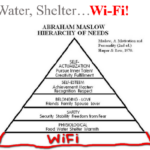I have been fortunate enough to experience firsthand several Wi-Fi architectures over the years. With the emergence of a second generation of 802.11ac enterprise products and the likes of professionals such as Lee Badman declaring Wireless Controllers are Dead, I thought it might be a great time to take a walk down memory lane regarding the evolution of Wi-Fi architectures. For those not fortunate enough to experience it firsthand, it truly has been a revolution.
1st Generation – Stand-alone APs
The first generation was stand-alone access points, also known as all-in-one, independent, autonomous, fat or thick APs. These were great for the home office, small office, or just spot coverage but the challenge was each AP had to be managed individually via CLI or a web GUI. The management, control, and data plane for each and every access point were separate. For those not familiar with the logical management, control and data planes (probably a history lesson in these days of cloud-managed Wi-Fi), the management plane is responsible for things like configuration, monitoring, reporting and firmware upgrades. The control plane is responsible for things like authentication, Radio Resource Management (RRM), Wireless Intrusion Detection (W-IDS) and L2/L3 mobility coordination. The data plane is responsible for client/user data forwarding.
Along came wireless gateways and centralized management systems such as the Bluesocket Wireless Gateway (WG) and Airwave Management Platform (AMP). While these system promised centralized AP management and even some security policy enforcement/guest access for the enterprise, the control and data plane for each and every access point remained separate. When I started out, folks were transitioning off this architecture to the next generation controller-based access points.
2nd Generation – Controller-based APs
This gave way to a second generation of controller-based access points also known as dependent, thin, dumb or lightweight APs. Circa 2005, these specialized hardware-based controllers from the likes of Cisco, Aruba, Bluesocket, Meru, etc. provided centralized management, control, and data planes. Data was tunneled from the APs to the controller for policy enforcement.
3rd Generation – Controller-based APs with Split MAC/Tunnel
Circa 2006/2007 with 802.11n on the horizon and the potential bottleneck of all that expected traffic, controller-based APs with Split MAC/Tunnel also known as dependent, thin, dumb or lightweight APs with split MAC/tunnel began to emerge by the likes of Bluesocket (edge-2-edge), Colubris, Cisco H-Reap, etc. These solutions provided centralized management and control planes with a distributed data plane. Client data was NOT tunneled from the access point to the controller for policy enforcement but instead remained at the edge at the access point. While these early solutions solved the bottleneck and single point of failure challenges of the previous generation, they typically came at a sacrifice of features since APs were not yet intelligent or smart. For example limited authentication methods, no firewall, no fast roaming, no layer 3 mobility, etc. depending on the vendor.
4th Generation – Virtualized, Controller-less or Cloud-based
Circa 2010 along came virtualized, controller-less or cloud-based solutions. These were also known as distributed or out-of-band, and APs were often referred to as intelligent or smart. Two trend setters emerged in the enterprise, Bluesocket vWLAN and Aerohive each having slightly different approaches. While Bluesocket provided centralized management and control virtualized on a hypervisor with distributed data at the APs, Aerohive provided centralized management with distributed control and data amongst the APs. Both solved many of the challenges that came with previous generation solutions such as single points of failure, bottlenecks, stacking controllers and aggregating controller interfaces, sizing controllers just right to account for growth and traffic u-turns.
We have seen Bluesocket purchased by ADTRAN for this technology, Meraki get scooped up by Cisco for $1.2 B, Aerohive go IPO and many new players such as Airtight emerge. Many vendors who were reliant on hardware-based controller revenue have since followed suite and this architecture serves as the foundation of today’s cloud-managed Wi-Fi.







Recent Comments